Summary In the last month of March 2010, the Central Rift veterinary unit was mainly involved in Bovine tuberculosis disease surveillance and research
Summary
In the last month of March 2010, the Central Rift veterinary unit was mainly involved in Bovine tuberculosis disease surveillance and research. A total of 42 African buffaloes (Syncerus caffer) from 4 different herds were captured by darting and tested using STAT-PAK® test within Maasai Mara National Reserve.
Some of the other veterinary interventions include the treatment of an adult male elephant with an injury on the right front leg in Olare-Orok Conservancy in Mara and removal of a snare and treatment of an Impala near Oloolaimutiak gate in Mara. Currently, there are a lot of heavy rains within Mara game reserve and its surroundings, most wildlife species have moved outside the reserve into the dispersal areas to avoid wet conditions and high grass levels in the reserve. This is likely to increase incidences of human-wildlife conflict within the surrounding community areas.
Bovine tuberculosis disease surveillance in African buffaloes of Maasai Mara
Bovine tuberculosis is a zoonotic disease caused by Mycobacterium bovis; it infects a wide range of species and is increasingly being recognized as an important pathogen of free-ranging African wildlife (Keet et al., 2001). In Kenya, the prevalence of bovine tuberculosis in wildlife is still unknown (Tarara et. al, 1985), but there have been reported cases in baboons Papio cynocephalus in the Maasai Mara National Game reserve, (Tarara et al, 1985) an indication that some wild animal species could be infected within the Mara ecosystem.
The disease has also been reported in lions of Serengeti National park in Tanzania (S. Cleaveland, et, al 2002) which borders Maasai Mara on the southern side and chances of disease transmission between these two wildlife conservation areas is quite high because of high concentration of livestock and wildlife and due to frequent wildlife-livestock interaction. There is need for investigation of the prevalence of bovine tuberculosis in wildlife and livestock of Kenya, particularly in Maasai Mara and Amboseli areas which are at the Kenya-Tanzania border and characterized by cross-border wildlife movements and livestock trade.
During the month of March, 2010, several buffaloes from different herds in different locations were captured by darting and blood samples collected for bovine tuberculosis disease testing. The blood samples were to be tested by two different serological tests, Bovigam® and Stat-Pak® tests.
STAT-PAK® testing of African buffaloes (Syncerus caffer) in Maasai Mara
A total of 42 African buffaloes (Syncerus caffer) from 4 different herds were captured by darting and tested using STAT-PAK® test within Maasai Mara National Reserve. The target buffaloes were adults which were seemingly weak or emaciated. They were captured by darting from a vehicle using 5mgs of etorphine hydrochloride combined with 50mgs of xylazine hydrochloride.
Blood was drawn from the jugular vein using vaccutainer needles into 10ml plain tubes coated with clot retractor and into heparin coated tubes. Age, body condition and GPS location were recorded. The blood was centrifuged at 1500 rpm for 15 minutes then plasma used to run the STAT-PAK test according to VetTB stat-Pak manufacturer’s procedure manual. Most of the buffaloes tested negative for bovine tuberculosis, the results will be confirmed by further bacteriological tests and Bovigam tests. Other species of animals such as elephant and impala were tested opportunistically during routine treatments. 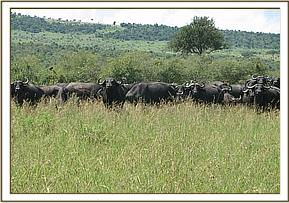
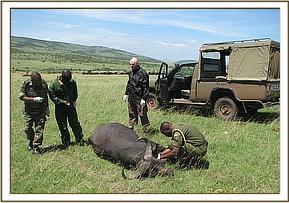
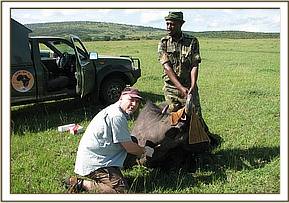

Treatment of an elephant bull with a traumatic injury on the leg in Olare-Orok Conservancy, Mara
This was a case of an adult male elephant which had an abscess and a wound on the medial side of the right front leg slightly above the spool. The wound was already infected with a lot of pus and fluid accumulation; the elephant could only walk slowly and carefully while avoiding much weight on the affected leg. It was suspected that the animal could have been stabbed by a sharp object probably an arrow that later on dropped off. This elephant was sighted by the Olare-Orok Conservancy rangers who reported to the veterinarian immediately for action to be taken.
Chemical immobilization, examination and treatment
The elephant was darted from a vehicle using 18mgs of etorphine Hcl and 1500 i.u, the drug took effect after about 5 minutes and it became recumbent. The wound was cleaned with a lot of water and gauze swabs removing all the mud and dirt from the infected site, and then the wound was probed carefully using a long forceps to find out if there was a foreign material inside and how deep it penetrated into the tissues.
After examination, it was realized that there was no foreign material in it and the wound was only affecting the soft tissues and cartilages. The wound was further cleaned using 10% hydrogen peroxide and it was slit open to enhance drainage of all the accumulated pus and tissue debris, then further treated with a tincture of iodine and oxytetracycline spray.
Further treatments by intramuscular administration of long-acting oxytetracycline antibiotics, multivitamins and dexamethasone were provided. Blood samples were collected for testing of various infections including bovine tuberculosis.
Revival of anesthesia
After treatment, the elephant was revived from anaesthesia using 60mgs of diprenorphine hydrochloride administered through the superficial ear-vein. It had good prognosis and higher chances of recovery after the treatment. It was to be monitored closely by the Conservancy rangers to know the progress.
Removal of a wire snare and treatment of a female impala near Oloolaimutiak gate in Mara
An adult female impala was sighted with a tight wire snare hanging round its neck. It was in a large herd of about 60 impalas near Oloolaimutiak gate. The snare was tightly encircling the neck but had not cut through the skin and muscles of the neck. It had not inflicted any injury to the animal even though it was strangling the neck and affecting its movement.
The impala was captured by darting using 5mgs of etorphine hydrochloride combined with 20mgs of xylazine hydrochloride. The drug took effect after about 10 minutes and the animal went down. It was then revived from anaesthesia immediately and then physically restrained by hands; this helped to minimize the effects of anesthetics on the physiology of the impala.
The wire was then cut off using a wire cutter then blood samples drawn from the jugular vein to be used for health monitoring purposes. After a successful treatment, it was released back to the wild. It had good prognosis of recovery after removal of the wire and relieving it from the pain of being strangled by the wire. 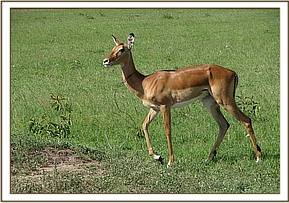
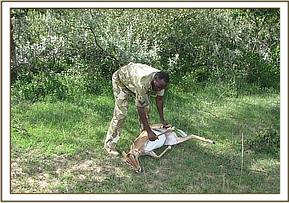
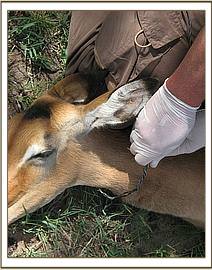

Conclusion
During the month of March, 2010, the Mara veterinary unit was involved in Bovine tuberculosis disease surveillance and research in wildlife and also responded to all reported cases of sick and injured wildlife species within Maasai Mara National Reserve. One bull elephant and one female impala were attended to and successfully treated.
Kenya Wildlife Service acknowledges the support of David Sheldrick Wildlife Trust (DSWT) towards provision of prompt veterinary services to wildlife in Maasai Mara ecosystem, Central Rift region and Ruma National park.
Report by: Dr. Dominic Mijele